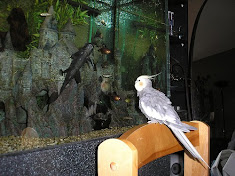Diet and hydration are, of course, crucial elements to caring for your scaly friend. Snakes need plenty of fresh water, so top up your pet's supply regularly. Don't be surprised if your snake doesn't eat up immediately. Many wait until nightfall to eat - most prefer to eat in the dark. So snakes may leave the prey for several hours before tackling it. Often, they drag their prey into their hide box before consumption.
 |
| Mouse Dinner for the Snake by Ferdi |
Creatures like lizards, small mammals, birds, fish, snails, insects and even other snakes can all be on the menu, with some variation between breeds. If the prey is capable of attack, for example if it is a rodent like a rat or a mouse, it will need to kill before eating. Defenseless creatures like earthworms frogs or insects will simply be swallowed whole.
One of the first and most important decisions is whether to give your snake pre-killed or live prey, and this debate continues to engage snake keepers. Really it comes down to personal preference, and there are pros and cons to both ways of feeding. If you go for the pre-killed option, be sure to have enough separate freezer space. Raising your own prey to kill, or having to go out to the pet store every time you need more food, can be expensive and time-consuming.
Frozen prey must be thoroughly thawed and warmed in advance. Defrost in the fridge or cool water, and heat slightly in warm water ahead of feeding. If you are feeding an already killed mouse, use tongs to dangle the animal in front of your snake. Use your fingers and your snake may think they're on the menu, too, and bite you. But if you don't want the hassle of defrosting and warming food, you may prefer to give your snake live prey. Just be aware that the snag with live prey like mice is that rodents will bite and scratch as long as they can, and can inflict serious injuries on a snake, especially if the reptile makes a mistake when trying to make the kill.
Whichever option you choose, go for food that's the size of the snake's girth at its largest. And whether you are going for the pre-killed or live option, get your snake used to this type of food as early on in its life as possible. You should find snakes fairly low maintenance when it comes to food. Just find out when and what and how much it needs to eat and stick to it.
Author Resource: Written by Daphne Reid
Find more Snake Care Articles at PetPeoplesPlace.com



0 comments:
Post a Comment